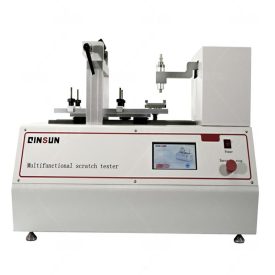
Multi functional scratch resistant instrument
Main use:
The multifunctional scratch resistance tester integrates three common testing methods in the automotive industry: five finger scratch, hundred grid scratch, and plastic scratch. It is used to test the scratch resistance of various automotive interior and exterior materials (plastic, rubber, leather, fabric, coating materials, non coating materials, and other composite materials, paint, ink, soft metals, etc.).
Compliant with standards:
PV3952, PV3974, GMW 14688, GMW 14698-A, Ford BN 108-13, General Motors GMN 3943, Danmler ChryslerLP-463DD-18-01, GB2918, GB6151, GB8424.3, BMW GS 97034, STD1024-3113
Applicable scope:
This instrument is suitable for testing the scratch resistance of various automotive interior materials, such as plastics, rubber, leather, fabrics, coated materials, non coated materials, and other composite materials.
Product details:
Multi functional scratch tester, also known as: scratch tester, scratch tester, scratch tester, five finger scratch tester, scratch tester, scratch tester, scratch tester, scratch tester.
The multifunctional scratch resistance tester is suitable for testing the scratch performance of various automotive interior materials. The instrument integrates three domestic testing standards (five finger scratch method, hundred grid method, and plastic scratch finger scratch method).
1、 Hundred grid scraping method
Testing principle:
Mainly represented by General GMW14688 and Volkswagen PV3952, a metal scraper with a certain diameter (usually 0.5mm or 1mm) is used to scrape two sets of parallel scratches perpendicular to each other on the surface of the product with a force of 5-15N. Then, the color difference or blackness changes in the scratch area before and after scraping are measured to evaluate the scratch resistance of the material.
Technical parameters:
1. Instrument power supply: 115/230 VAC, 50/60Hz (please specify voltage when ordering);
2. Equipment power: 400W;
3. Specification of test piece: 80 × 50mm;
4. Sample thickness: 0.5-20mm;
5. Standard load range: 2-50N (rounded to 2N);
6. Special load range: 1-10N (rounded to 1N) (must be matched with optional accessories);
7. Marking path: 25 or 45mm;
8. Scratching speed: 1m/min or 40mm/s.
2、 Five Finger Scratching
Testing principle:
Fix the sample on the test bench, with one end of the scraping rod fixed with tungsten carbide material and a highly polished scraping head with a diameter of 1mm or 7mm. The other end of the scraping rod is fixed with a weight. The installation position, quantity, and load of the scraping rod are determined based on the sample size and testing requirements. The scraping distance is generally set at 100mm to 200mm, and the scraping speed is 100mm/s. After the test is completed, visually inspect the scratches under bright northern sky sunlight or D65 standard light source, Evaluate the scratch resistance of the material.
Technical parameters:
1. Travel range: 10-200mm;
2. Speed range: 10-200mm/s;
3. Speed buffer: 10 ± 1mm;
4. Tungsten carbide scratch fingertips (5PCS): spherical with a diameter of 1.0mm;
5. Tungsten carbide scratch fingertips (5PCS): spherical with a diameter of 7.0mm;
6. Nine weight settings (2N, 3N, 4.5N, 5N, 6N, 7N, 10N, 15N, 20N);
7. Plastic scraper: Polymethyl methacrylate (PMMA);
i. Diameter: 16mm; Thickness: 1mm;
Ii. The radius of the edge of the scratch finger is 0.5mm;
Iii. The hardness is shore D85.
8. Equipment power supply: AC220V ± 10%, 50Hz.
Scratching principle:
This test method is used to test the ability of surface materials to resist damage caused by finger scraping. According to the nails or other hard objects that may come into contact with during the use of materials, different materials of scraping fingers are used. According to the specified direction, stroke, and speed, a certain pressure is applied to the surface of the sample. The scraping head and the sample move relative to each other, producing a unidirectional, non reciprocating linear scraping trajectory, and the scratches are kept parallel. The final evaluation of the scratch sensory level of the material, the color difference between the scratched and non scratched areas, or the minimum scratch force when the sample surface is damaged.
Instrument features:
The instrument consists of a motor drive mechanism, a scraping component, a sample clamping and fixing device, etc.
2. The scraping component includes a scraping bracket, a scraping finger, a scraping finger positioning sleeve, a pressure device (weight and weight support rod), etc.
3. The instrument can be freely installed, replaced, and disassembled with different specifications of scraping fingers, and can perform uniform speed unidirectional linear scraping motion under different loads.
4. The testing process is automatically controlled using embedded systems and human-machine interface operations. Precise servo motors and ball screws are used for transmission, which plays a decisive role in the accuracy of scraping speed control under relevant standards.
5. Use tungsten carbide material for scraping fingers to increase the service life of the instrument.
6. Made of aluminum alloy and stainless steel materials, the appearance is simple, lightweight, and corrosion-resistant.
Technical parameters:
1. Travel range: 10-200mm;
2. Speed range: 10-200mm/s;
3. Speed buffer: 10 ± 1mm;
4. Metal scraper head diameter: 0.5mm, 0.75mm, 1mm (Erichsen318), 3mm, 5mm, 7mm;
5. Material of metal scraper head: tungsten carbide;
6. Total weight of pressurized weights and scraping components: 2N, 3N, 5N, 7N, 8N, 10N, 12N, 15N, 20N (optional), with a mass error not exceeding 1%;
7. Plastic scraper: Polymethyl methacrylate (PMMA);
i. 16mm diameter with a thickness of 1mm;
Ii The radius of the scraping edge is 0.5mm;
Iii. The hardness is shore D85.
8. Power supply: AC220V ± 10%, 50Hz.